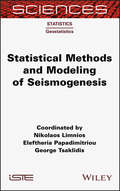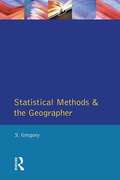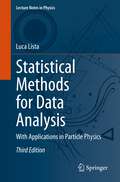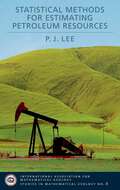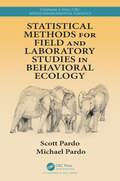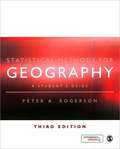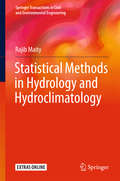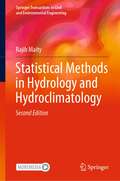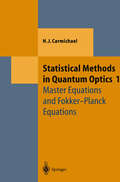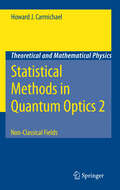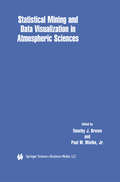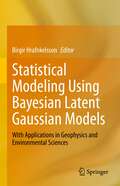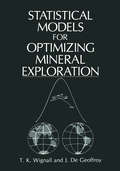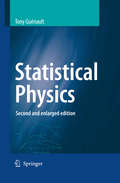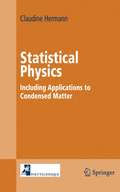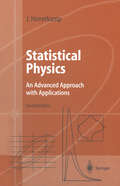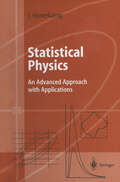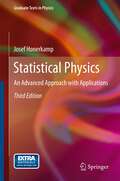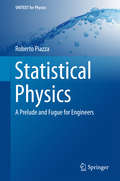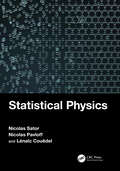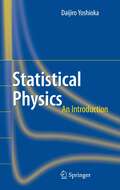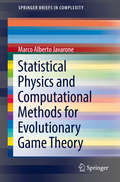- Table View
- List View
Statistical Methods and Modeling of Seismogenesis
by Nikolaos Limnios Eleftheria Papadimitriou George TsaklidisThe study of earthquakes is a multidisciplinary field, an amalgam of geodynamics, mathematics, engineering and more. The overriding commonality between them all is the presence of natural randomness. Stochastic studies (probability, stochastic processes and statistics) can be of different types, for example, the black box approach (one state), the white box approach (multi-state), the simulation of different aspects, and so on. This book has the advantage of bringing together a group of international authors, known for their earthquake-specific approaches, to cover a wide array of these myriad aspects. A variety of topics are presented, including statistical nonparametric and parametric methods, a multi-state system approach, earthquake simulators, post-seismic activity models, time series Markov models with regression, scaling properties and multifractal approaches, selfcorrecting models, the linked stress release model, Markovian arrival models, Poisson-based detection techniques, change point detection techniques on seismicity models, and, finally, semi-Markov models for earthquake forecasting.
Statistical Methods and the Geographer
by S GregoryFirst published in 1978. Routledge is an imprint of Taylor & Francis, an informa company.
Statistical Methods and the Geographer
by S GregoryFirst published in 1978. Routledge is an imprint of Taylor & Francis, an informa company.
Statistical Methods for Data Analysis: With Applications in Particle Physics (Lecture Notes in Physics #1010)
by Luca ListaThis third edition expands on the original material. Large portions of the text have been reviewed and clarified. More emphasis is devoted to machine learning including more modern concepts and examples. This book provides the reader with the main concepts and tools needed to perform statistical analyses of experimental data, in particular in the field of high-energy physics (HEP).It starts with an introduction to probability theory and basic statistics, mainly intended as a refresher from readers’ advanced undergraduate studies, but also to help them clearly distinguish between the Frequentist and Bayesian approaches and interpretations in subsequent applications. Following, the author discusses Monte Carlo methods with emphasis on techniques like Markov Chain Monte Carlo, and the combination of measurements, introducing the best linear unbiased estimator. More advanced concepts and applications are gradually presented, including unfolding and regularization procedures, culminating in the chapter devoted to discoveries and upper limits.The reader learns through many applications in HEP where the hypothesis testing plays a major role and calculations of look-elsewhere effect are also presented. Many worked-out examples help newcomers to the field and graduate students alike understand the pitfalls involved in applying theoretical concepts to actual data.
Statistical Methods for Estimating Petroleum Resources (International Association for Mathematical Geology Studies in Mathematical Geology)
by P.J. LeeThis book describes procedures for determining the total hydrocarbon (petroleum) resource or resource potential in a region. Statistical concepts and methods employed in petroleum resource assessment are the subject of the manuscript, extensively illustrated by numerous real case studies. Prof. Lee's computer-aided Petroleum Information Management and Resource Evaluation System (PETRIMES) methodology has been adopted by governments around the world and by major multinational oil companies to perform resource assessment and to predict future oil and gas production. Though this methodology is so widely used, there is no "user's guide" to it, and this book will be the definitive resource for PETRIMES users.
Statistical Methods for Field and Laboratory Studies in Behavioral Ecology (Chapman & Hall/CRC Applied Environmental Statistics)
by Scott Pardo Michael PardoStatistical Methods for Field and Laboratory Studies in Behavioral Ecology focuses on how statistical methods may be used to make sense of behavioral ecology and other data. It presents fundamental concepts in statistical inference and intermediate topics such as multiple least squares regression and ANOVA. The objective is to teach students to recognize situations where various statistical methods should be used, understand the strengths and limitations of the methods, and to show how they are implemented in R code. Examples are based on research described in the literature of behavioral ecology, with data sets and analysis code provided. Features: This intermediate to advanced statistical methods text was written with the behavioral ecologist in mind Computer programs are provided, written in the R language. Datasets are also provided, mostly based, at least to some degree, on real studies. Methods and ideas discussed include multiple regression and ANOVA, logistic and Poisson regression, machine learning and model identification, time-to-event modeling, time series and stochastic modeling, game-theoretic modeling, multivariate methods, study design/sample size, and what to do when things go wrong. It is assumed that the reader has already had exposure to statistics through a first introductory course at least, and also has sufficient knowledge of R. However, some introductory material is included to aid the less initiated reader. Scott Pardo, Ph.D., is an accredited professional statistician (PStat®) by the American Statistical Association. Michael Pardo is a Ph.D. is a candidate in behavioral ecology at Cornell University, specializing in animal communication and social behavior.
Statistical Methods for Field and Laboratory Studies in Behavioral Ecology (Chapman & Hall/CRC Applied Environmental Statistics)
by Scott Pardo Michael PardoStatistical Methods for Field and Laboratory Studies in Behavioral Ecology focuses on how statistical methods may be used to make sense of behavioral ecology and other data. It presents fundamental concepts in statistical inference and intermediate topics such as multiple least squares regression and ANOVA. The objective is to teach students to recognize situations where various statistical methods should be used, understand the strengths and limitations of the methods, and to show how they are implemented in R code. Examples are based on research described in the literature of behavioral ecology, with data sets and analysis code provided. Features: This intermediate to advanced statistical methods text was written with the behavioral ecologist in mind Computer programs are provided, written in the R language. Datasets are also provided, mostly based, at least to some degree, on real studies. Methods and ideas discussed include multiple regression and ANOVA, logistic and Poisson regression, machine learning and model identification, time-to-event modeling, time series and stochastic modeling, game-theoretic modeling, multivariate methods, study design/sample size, and what to do when things go wrong. It is assumed that the reader has already had exposure to statistics through a first introductory course at least, and also has sufficient knowledge of R. However, some introductory material is included to aid the less initiated reader. Scott Pardo, Ph.D., is an accredited professional statistician (PStat®) by the American Statistical Association. Michael Pardo is a Ph.D. is a candidate in behavioral ecology at Cornell University, specializing in animal communication and social behavior.
Statistical Methods For Geography (PDF)
by Peter RogersonThe Third Edition of this bestselling student favourite has again been revised and updated to provide an expert introduction to the principal methods and techniques needed to understand a statistics module.
Statistical Methods in Hydrology and Hydroclimatology (Springer Transactions in Civil and Environmental Engineering)
by Rajib MaityThis book focuses on the application of statistical methods in the field of hydrology and hydroclimatology. Among the latest theories being used in these fields, the book introduces the theory of copulas and its applications in this context. The purpose is to develop an understanding and illustrate the usefulness of the statistical techniques with detailed theory and numerous worked out examples. Apart from this, MATLAB-based codes and solutions of some worked out examples are also provided to assist the readers to handle real life data. This book presents a comprehensive knowledge of statistical techniques combining the basics of probability and the current advances in stochastic hydrology. Besides serving as a textbook for graduate courses on stochastic modeling in hydrology and related disciplines, the book offers valuable resources for researchers and professionals involved in the field of hydrology and climatology.
Statistical Methods in Hydrology and Hydroclimatology (Springer Transactions in Civil and Environmental Engineering)
by Rajib MaityThis second edition focuses on the application of statistical methods in the field of hydrology and hydroclimatology. Among the latest theories being used in these fields, the book introduces the theory of copulas and its applications in this context. The purpose is to develop an understanding and illustrate the usefulness of the statistical techniques with detailed theory and numerous worked out examples. Apart from this, sample scripts based on MATLAB, Python and R for some examples are also provided to assist the readers to handle real life data. Besides serving as a textbook for graduate courses on stochastic modeling in hydrology and related disciplines, the book offers a valuable resource for researchers and professionals involved in the field of hydrology and climatology.
Statistical Methods in Quantum Optics 1: Master Equations and Fokker-Planck Equations (Theoretical and Mathematical Physics)
by Howard J. CarmichaelThis is the first of a two-volume presentation on current research problems in quantum optics, and will serve as a standard reference in the field for many years to come. The book provides an introduction to the methods of quantum statistical mechanics used in quantum optics and their application to the quantum theories of the single-mode laser and optical bistability. The generalized representations of Drummond and Gardiner are discussed together with the more standard methods for deriving Fokker-Planck equations.
Statistical Methods in Quantum Optics 2: Non-Classical Fields (Theoretical and Mathematical Physics)
by Howard J. CarmichaelThis second volume of Howard Carmichael’s work continues the development of the methods used in quantum optics to treat open quantum systems and their fluctuations. Its early chapters build upon the phase-space methods introduced in Volume 1. Written on a level suitable for debut researchers or students in an advanced course in quantum optics, or a course in quantum mechanics or statistical physics that deals with open quantum systems.
Statistical Mining and Data Visualization in Atmospheric Sciences
by Paul W. Mielke Jr. Timothy J. BrownStatistical Mining and Data Visualization in Atmospheric Sciences brings together in one place important contributions and up-to-date research results in this fast moving area. Statistical Mining and Data Visualization in Atmospheric Sciences serves as an excellent reference, providing insight into some of the most challenging research issues in the field.
Statistical Modeling Using Bayesian Latent Gaussian Models: With Applications in Geophysics and Environmental Sciences
by Birgir HrafnkelssonThis book focuses on the statistical modeling of geophysical and environmental data using Bayesian latent Gaussian models. The structure of these models is described in a thorough introductory chapter, which explains how to construct prior densities for the model parameters, how to infer the parameters using Bayesian computation, and how to use the models to make predictions. The remaining six chapters focus on the application of Bayesian latent Gaussian models to real examples in glaciology, hydrology, engineering seismology, seismology, meteorology and climatology. These examples include: spatial predictions of surface mass balance; the estimation of Antarctica’s contribution to sea-level rise; the estimation of rating curves for the projection of water level to discharge; ground motion models for strong motion; spatial modeling of earthquake magnitudes; weather forecasting based on numerical model forecasts; and extreme value analysis of precipitation on a high-dimensional grid. The book is aimed at graduate students and experts in statistics, geophysics, environmental sciences, engineering, and related fields.
Statistical Models for Optimizing Mineral Exploration
by J.G. De Geoffroy T.K. WignallAfter the spectacular successes of the 1960's and 1970's, the mineral exploration business is at a crossroads, facing uncertain t:imes in the decades ahead. This situation requires a re-thinking of the philosophy guiding mineral exploration if it is to emulate its recent performance. The ma:i. n argument of a previous volume titled "Designing Opt:lmal Strategies for Mineral Exploration", published in 1985 by Plenum Publishing Corporation of New York, is that a possible answer to the challenge facing mineral explorationists lies in the philosophy of opt:irn1zation. This new approach should help exploration staff make the best achievable use of the sophisticated and costly technology which is presently available for the detection of ore deposits. The main emphasis of the present volume is placed on the mathematical and computational aspects of the opt:irn1zation of mineral exploration. The seven chapters making up the ma:i. n body of the book are devoted to the description and application of various types of computerized geomathematical models which underpin the optimization of the mineral exploration sequence. The topics covered include: (a) the opt:lmal selection of ore deposit types and regions of search, as well as prospecting areas within the regions (Chapters 2, 3, 4, 6), (b) the designing of airborne and ground field programs for the opt:lmal coverage of prospecting areas (Chapters 2, 3, 4), (c) delineation and evaluation of exploration targets within prospecting areas by means of opt:irn1zed models (Chapter 5).
Statistical Physics (Student Physics Series)
by A.M. GuenaultIn this revised and enlarged second edition, Tony Guénault provides a clear and refreshingly readable introduction to statistical physics. The treatment itself is self-contained and concentrates on an understanding of the physical ideas, without requiring a high level of mathematical sophistication. The book adopts a straightforward quantum approach to statistical averaging from the outset. The initial part of the book is geared towards explaining the equilibrium properties of a simple isolated assembly of particles. The treatment of gases gives full coverage to Maxwell-Boltzmann, Fermi-Dirac and Bose-Einstein statistics.
Statistical Physics: Including Applications to Condensed Matter
by Claudine HermannStatistical Physics bridges the properties of a macroscopic system and the microscopic behavior of its constituting particles, otherwise impossible due to the giant magnitude of Avogadro's number. Numerous systems of today's key technologies - such as semiconductors or lasers - are macroscopic quantum objects; only statistical physics allows for understanding their fundamentals. Therefore, this graduate text also focuses on particular applications such as the properties of electrons in solids with applications, and radiation thermodynamics and the greenhouse effect.
Statistical Physics: An Advanced Approach with Applications Web-enhanced with Problems and Solutions (Advanced Texts in Physics)
by Josef HonerkampThe book is divided into two parts. The first part looks at the modeling of statistical systems before moving on to an analysis of these systems. This second edition contains new material on: estimators based on a probability distribution for the parameters; identification of stochastic models from observations; and statistical tests and classification methods.
Statistical Physics: An Advanced Approach with Applications
by Josef HonerkampStatistical Physics offers an advanced treatment with numerous applications to modern problems of relevance to researchers and students. Supplementing the concepts and methods employed in statistical mechanics, the book also covers the fundamentals of probability and statistics, mathematical statistics, and stochastic methods for the analysis of data. It is divided into two parts, the first focusing on the modeling of statistical systems, the second on the analysis of these systems.
Statistical Physics: An Advanced Approach with Applications (Graduate Texts in Physics)
by Josef HonerkampThe application of statistical methods to physics is essential. This unique book on statistical physics offers an advanced approach with numerous applications to the modern problems students are confronted with. Therefore the text contains more concepts and methods in statistics than the student would need for statistical mechanics alone. Methods from mathematical statistics and stochastics for the analysis of data are discussed as well. The book is divided into two parts, focusing first on the modeling of statistical systems and then on the analysis of these systems. Problems with hints for solution help the students to deepen their knowledge. The third edition has been updated and enlarged with new sections deepening the knowledge about data analysis. Moreover, a customized set of problems with solutions is accessible on the Web at extras.springer.com.
Statistical Physics: A Prelude and Fugue for Engineers (UNITEXT for Physics)
by Roberto PiazzaThis book, provides a general introduction to the ideas and methods of statistical mechanics with the principal aim of meeting the needs of Master’s students in chemical, mechanical, and materials science engineering. Extensive introductory information is presented on many general physics topics in which students in engineering are inadequately trained, ranging from the Hamiltonian formulation of classical mechanics to basic quantum mechanics, electromagnetic fields in matter, intermolecular forces, and transport phenomena. Since engineers should be able to apply physical concepts, the book also focuses on the practical applications of statistical physics to material science and to cutting-edge technologies, with brief but informative sections on, for example, interfacial properties, disperse systems, nucleation, magnetic materials, superfluidity, and ultralow temperature technologies. The book adopts a graded approach to learning, the opening four basic-level chapters being followed by advanced “starred” sections in which special topics are discussed. Its relatively informal style, including the use of musical metaphors to guide the reader through the text, will aid self-learning.
Statistical Physics
by Nicolas Sator Nicolas Pavloff Lenaic CouedelThis book presents an introduction to the main concepts of statistical physics, followed by applications to specific problems and more advanced concepts, selected for their pedagogical or practical interest. Particular attention has been devoted to the presentation of the fundamental aspects, including the foundations of statistical physics, as well as to the discussion of important physical examples. Comparison of theoretical results with the relevant experimental data (with illustrative curves) is present through the entire textbook. This aspect is facilitated by the broad range of phenomena pertaining to statistical physics, providing example issues from domains as varied as the physics of classical and quantum liquids, condensed matter, liquid crystals, magnetic systems, astrophysics, atomic and molecular physics, superconductivity and many more. This textbook is intended for graduate students (MSc and PhD) and for those teaching introductory or advanced courses on statistical physics. Key Features: A rigorous and educational approach of statistical physics illustrated with concrete examples. A clear presentation of fundamental aspects of statistical physics. Many exercises with detailed solutions. Nicolas Sator is Associate Professor at Sorbonne University, Paris, France. He is a member of the Laboratory of Theoretical Physics of Condensed Matter (LPTMC) and his research focuses on the physics of liquids. Nicolas Pavloff is Professor at Paris-Saclay University, France. He is a member of Laboratoire de Physique Théorique et Modèles Statistiques (LPTMS) and his domain of research is quantum fluid theory. Lénaïc Couëdel is Professor at the University of Sasktchewan, Saskatoon, Canada and researcher at CNRS, France. His research area is plasma physics with a focus on complex plasma crystals.
Statistical Physics
by Nicolas Sator Nicolas Pavloff Lenaic CouedelThis book presents an introduction to the main concepts of statistical physics, followed by applications to specific problems and more advanced concepts, selected for their pedagogical or practical interest. Particular attention has been devoted to the presentation of the fundamental aspects, including the foundations of statistical physics, as well as to the discussion of important physical examples. Comparison of theoretical results with the relevant experimental data (with illustrative curves) is present through the entire textbook. This aspect is facilitated by the broad range of phenomena pertaining to statistical physics, providing example issues from domains as varied as the physics of classical and quantum liquids, condensed matter, liquid crystals, magnetic systems, astrophysics, atomic and molecular physics, superconductivity and many more. This textbook is intended for graduate students (MSc and PhD) and for those teaching introductory or advanced courses on statistical physics. Key Features: A rigorous and educational approach of statistical physics illustrated with concrete examples. A clear presentation of fundamental aspects of statistical physics. Many exercises with detailed solutions. Nicolas Sator is Associate Professor at Sorbonne University, Paris, France. He is a member of the Laboratory of Theoretical Physics of Condensed Matter (LPTMC) and his research focuses on the physics of liquids. Nicolas Pavloff is Professor at Paris-Saclay University, France. He is a member of Laboratoire de Physique Théorique et Modèles Statistiques (LPTMS) and his domain of research is quantum fluid theory. Lénaïc Couëdel is Professor at the University of Sasktchewan, Saskatoon, Canada and researcher at CNRS, France. His research area is plasma physics with a focus on complex plasma crystals.
Statistical Physics: An Introduction
by Daijiro YoshiokaThis book provides a comprehensive presentation of the basics of statistical physics. The first part explains the essence of statistical physics and how it provides a bridge between microscopic and macroscopic phenomena, allowing one to derive quantities such as entropy. Here the author avoids going into details such as Liouville’s theorem or the ergodic theorem, which are difficult for beginners and unnecessary for the actual application of the statistical mechanics. In the second part, statistical mechanics is applied to various systems which, although they look different, share the same mathematical structure. In this way readers can deepen their understanding of statistical physics. The book also features applications to quantum dynamics, thermodynamics, the Ising model and the statistical dynamics of free spins.
Statistical Physics and Computational Methods for Evolutionary Game Theory (SpringerBriefs in Complexity)
by Marco Alberto JavaroneThis book presents an introduction to Evolutionary Game Theory (EGT) which is an emerging field in the area of complex systems attracting the attention of researchers from disparate scientific communities. EGT allows one to represent and study several complex phenomena, such as the emergence of cooperation in social systems, the role of conformity in shaping the equilibrium of a population, and the dynamics in biological and ecological systems.Since EGT models belong to the area of complex systems, statistical physics constitutes a fundamental ingredient for investigating their behavior. At the same time, the complexity of some EGT models, such as those realized by means of agent-based methods, often require the implementation of numerical simulations. Therefore, beyond providing an introduction to EGT, this book gives a brief overview of the main statistical physics tools (such as phase transitions and the Ising model) and computational strategies for simulating evolutionary games (such as Monte Carlo algorithms on lattices). This book will appeal to students and researchers in this burgeoning field of complex systems.
